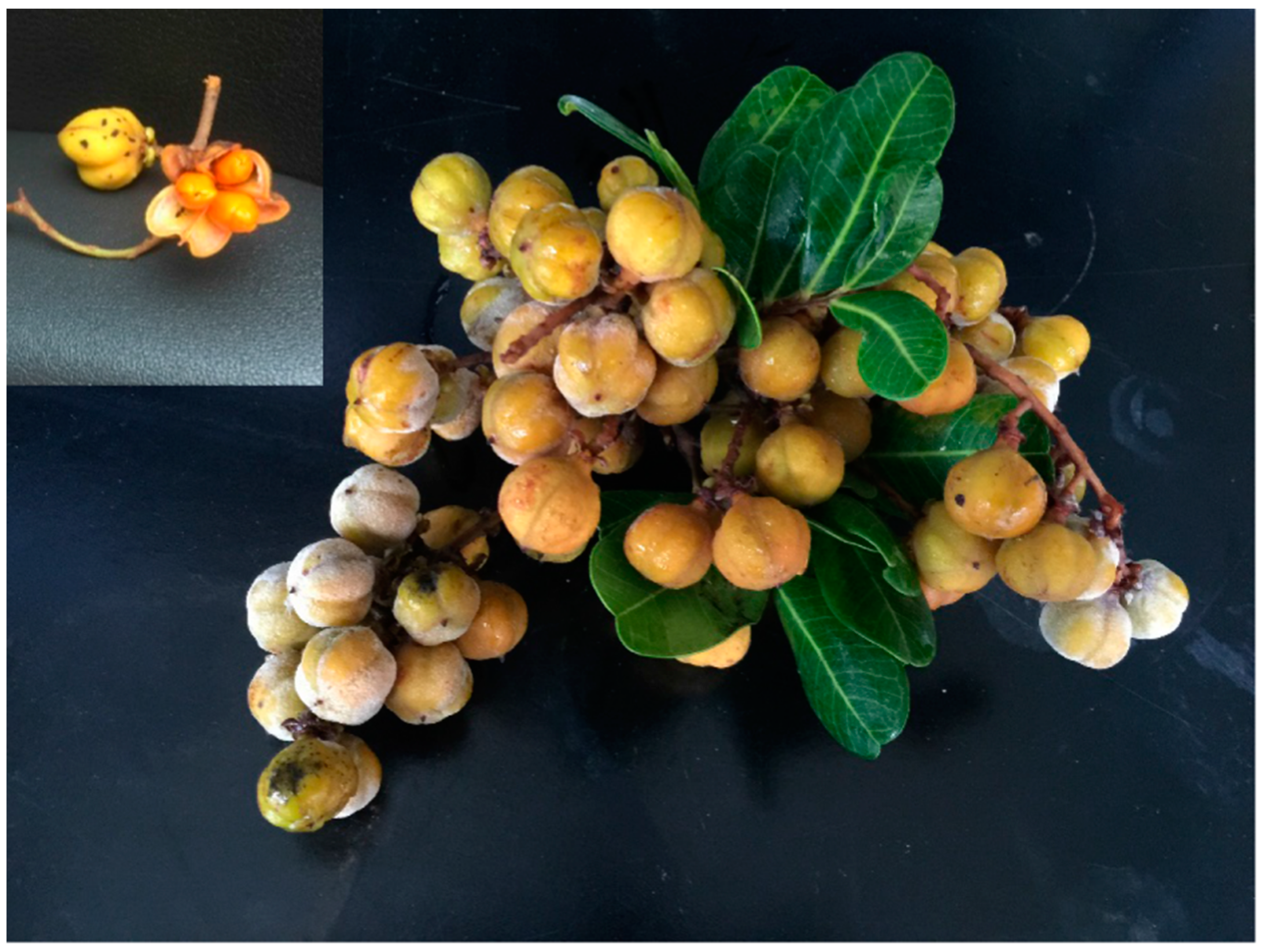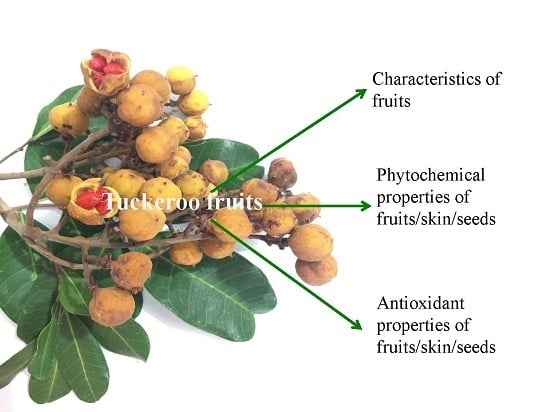Characterising the Physical, Phytochemical and Antioxidant Properties of the Tuckeroo (Cupaniopsis anacardioides) Fruit
Abstract
:1. Introduction
2. Materials and Methods
2.1. Materials
2.2. Methods for Characterisation of Tuckeroo (Cupaniopsis anacardioides) Fruits
2.2.1. Diameter of the Fruits
2.2.2. Weight of the Whole Fruit and Fruit Components
2.2.3. Moisture Content
2.3. Extraction
2.4. Determination of Phenolic Content and Its Secondary Metabolites
2.4.1. Total Phenolic Content
2.4.2. Flavonoids
2.4.3. Proanthocyanidins
2.5. Determination of Antioxidant Capacity
2.5.1. ABTS Radical Scavenging Activity
2.5.2. DPPH Radical Scavenging Activity
2.5.3. Cupric-Reducing Antioxidant Capacity
2.5.4. Ferric Antioxidant Power
2.6. Extraction Yields
2.7. Statistical Analysis
3. Results and Discussion
3.1. Physical Characteristics of the Tuckeroo Fruit
3.2. Extraction Yields, Phenolic Content and Antioxidant Capacity of the Tuckeroo Fruits as Influenced by Extraction Solvents
3.3. Phytochemical and Antioxidant Characteristics of the Tuckeroo Fruit
4. Conclusions
Acknowledgments
Author Contributions
Conflicts of Interest
References
- Mohanty, S.; Cock, I.E. The chemotherapeutic potential of Terminalia ferdinandiana: Phytochemistry and bioactivity. Pharmacogn. Rev. 2012, 6, 29–36. [Google Scholar] [PubMed]
- Vuong, Q.V.; Hirun, S.; Phillips, P.A.; Chuen, T.L.K.; Bowyer, M.C.; Goldsmith, C.D.; Scarlett, C.J. Fruit-derived phenolic compounds and pancreatic cancer: Perspectives from australian native fruits. J. Ethnopharmacol. 2014, 152, 227–242. [Google Scholar] [CrossRef] [PubMed]
- Floyd, A.G. Rainforest Trees of Mainland South-Eastern Australia; Inkata Press: Melbourne, Australia, 1989; p. 420. [Google Scholar]
- Everitt, J.; Alaniz, M. Nutrient content of cactus and woody plant fruits eaten by birds and mammals in south texas. Southwest. Nat. 1981, 26, 301–305. [Google Scholar] [CrossRef]
- Dailey, A.; Vuong, Q.V. Effect of extraction solvents on recovery of bioactive compounds and antioxidant properties from macadamia (Macadamia tetraphylla) skin waste. Cogent Food Agric. 2015, 1, 1115646. [Google Scholar] [CrossRef]
- Vuong, Q.V.; Hirun, S.; Roach, P.D.; Bowyer, M.C.; Phillips, P.A.; Scarlett, C.J. Effect of extraction conditions on total phenolic compounds and antioxidant activities of carica papaya leaf aqueous extracts. J. Herb. Med. 2013, 3, 104–111. [Google Scholar] [CrossRef]
- Wu, S.-J.; Ng, L.-T. Antioxidant and free radical scavenging activities of wild bitter melon (Momordica charantia Linn. var. abbreviata Ser.) in Taiwan. Lwt Food Sci. Technol. 2008, 41, 323–330. [Google Scholar] [CrossRef]
- Li, Y.; Guo, C.; Yang, J.; Wei, J.; Xu, J.; Cheng, S. Evaluation of antioxidant properties of pomegranate peel extract in comparison with pomegranate pulp extract. Food. Chem. 2006, 96, 254–260. [Google Scholar] [CrossRef]
- Thaipong, K.; Boonprakob, U.; Crosby, K.; Cisneros-Zevallos, L.; Byrne, D.H. Comparison of ABTS, DPPH, FRAP, and ORAC assays for estimating antioxidant activity from guava fruit extracts. J. Food Compos. Anal. 2006, 19, 669–675. [Google Scholar] [CrossRef]
- Apak, R.; Guclu, K.; Ozyurek, M.; Karademir, S.E. Novel total antioxidant capacity index for dietary polyphenols and vitamins C and E, using their cupric ion reducing capability in the presence of neocuproine: CUPRAC method. J. Agric. Food Chem. 2004, 52, 7970–7981. [Google Scholar] [CrossRef] [PubMed]
- Vuong, Q.V.; Golding, J.B.; Nguyen, M.H.; Roach, P.D. Production of caffeinated and decaffeinated green tea catechin powders from underutilised old tea leaves. J. Food Eng. 2012, 110, 1–8. [Google Scholar] [CrossRef]
- Ochmian, I.D.; Skupien, K.; Grajkowski, J.; Smolik, M.; Ostrowska, K. Chemical composition and physical characteristics of fruits of two cultivars of blue honeysuckle (Lonicera caerulea L.) in relation to their degree of maturity and harvest date. Notulae Botanicae Horti Agrobotanici Cluj-Napoca 2012, 40, 155. [Google Scholar]
- Pinelo, M.; Rubilar, M.; Sineiro, J.; Nunez, M. Extraction of antioxidant phenolics from almond hulls (Prunus amygdalus) and pine sawdust (Pinus pinaster). Food Chem. 2004, 85, 267–273. [Google Scholar] [CrossRef]
- Papoutsis, K.; Pristijono, P.; Golding, J.B.; Stathopoulos, C.E.; Scarlett, C.J.; Bowyer, M.C.; Van Vuong, Q. Impact of different solvents on the recovery of bioactive compounds and antioxidant properties from lemon (Citrus limon L.) pomace waste. Food Sci. Biotechnol. 2016, 25, 971–977. [Google Scholar] [CrossRef]
- Turkmen, N.; Sari, F.; Velioglu, Y.S. Effects of extraction solvents on concentration and antioxidant activity of black and black mate tea polyphenols determined by ferrous tartrate and folin–ciocalteu methods. Food Chem. 2006, 99, 835–841. [Google Scholar] [CrossRef]
- Musa, K.H.; Abdullah, A.; Jusoh, K.; Subramaniam, V. Antioxidant activity of pink-flesh guava (Psidium guajava L.): Effect of extraction techniques and solvents. Food Anal. Methods 2011, 4, 100–107. [Google Scholar] [CrossRef]
- Netzel, M.; Netzel, G.; Tian, Q.; Schwartz, S.; Konczak, I. Native australian fruits—A novel source of antioxidants for food. Innov. Food Sci. Emerg. Technol. 2007, 8, 339–346. [Google Scholar] [CrossRef]
- Tan, A.C.; Konczak, I.; Ramzan, I.; Sze, D.M.-Y. Native australian fruit polyphenols inhibit cell viability and induce apoptosis in human cancer cell lines. Nutr. Cancer 2011, 63, 444–455. [Google Scholar] [CrossRef] [PubMed]
- Vuong, Q.V.; Hirun, S.; Chuen, T.L.; Goldsmith, C.D.; Bowyer, M.C.; Chalmers, A.C.; Phillips, P.A.; Scarlett, C.J. Physicochemical composition, antioxidant and anti-proliferative capacity of a lilly pilly (Syzygium paniculatum) extract. J. Herb. Med. 2014, 4, 134–140. [Google Scholar] [CrossRef]
- Güçlü, K.; Altun, M.; Özyürek, M.; Karademir, S.E.; Apak, R. Antioxidant capacity of fresh, sun-and sulphited-dried Malatya apricot (Prunus armeniaca) assayed by CUPRAC, ABTS/TEAC and folin methods. Int. J. Food Sci. Technol. 2006, 41, 76–85. [Google Scholar] [CrossRef]
- Krishnan, R.; Maru, G.B. Isolation and analyses of polymeric polyphenol fractions from black tea. Food Chem. 2006, 94, 331–340. [Google Scholar] [CrossRef]
- Lopes, M.L.M.; Miguel, M.A.L.; Fialho, E.; Valente-Mesquita, V.L. Grape juice obtained using steam extraction and other small-scale extraction methods: Phenolic content, antioxidant capacity and stability during storage. Int. J. Food Sci. Technol. 2016, 51, 1696–1702. [Google Scholar] [CrossRef]


| Characteristics | Mean ± Standard Deviation |
|---|---|
| Whole fruit weight (g) | 3.20 ± 0.08 |
| Seed (%) of fruit weight | 15.67 ± 0.76 |
| Flesh (%) of fruit weight | 7.03 ± 0.09 |
| Skin (%) of fruit weight | 77.31 ± 1.26 |
| Fruit moisture (%) | 68.94 ± 1.17 |
| Seed moisture (%) | 42.52 ± 1.98 |
| Flesh moisture (%) | 56.16 ± 0.68 |
| Skin moisture (%) | 76.48 ± 0.40 |
| Diameter of fruit (mm) | 20.56 ± 9.24 |
| Length of fruit (mm) | 17.34 ± 3.80 |
| Solvents | EY (g/100 g Sample) | TPC (mg GAE/g Dried Sample) | TFC (mg CAE/g Dried Sample) | Proanth (mg CAE/g Dried Sample) | FRAP (mg TE/g Dried Sample) | CUPRAC (mg TE/g Dried Sample) | DPPH (mg TE/g Dried Sample) | ABTS (mg TE/g Dried Sample) |
|---|---|---|---|---|---|---|---|---|
| Water | 35.78 ± 0.10 c | 49.14 ± 1.04 f | 30.5 ± 0.75 d | 20.47 ± 0.09 f | 76.03 ± 0.63 f | 165.16 ± 4.88 f | 158.84 ± 2.53 e | 182.4 ±1.58 d |
| Methanol | 44.22 ± 0.77 a | 95.99 ± 1.35 d | 49.32 ± 1.06 c | 58.18 ± 0.39 c | 135.56 ± 0.20 d | 324.97 ± 3.55 d | 329.80 ± 6.64 b | 268.7 ±5.51 c |
| Methanol 50% | 44.1 ± 0.20 a | 106.23 ± 0.97 b | 67.67 ± 0.82 b | 56.74 ± 1.9 c | 176.30 ± 0.41 b | 370.12 ± 4.00 a | 263.78 ± 2.95 d | 346.98 ±1.59 a |
| Ethanol | 33 ± 0.72 d | 53 ± 0.72 e | 27.33 ± 1.03 e | 33.93 ± 0.6 e | 78.96 ± 1.98 e | 187.47 ± 1.87 e | 155.56 ± 3.01 e | 136.57 ±5.54 e |
| Ethanol 50% | 43.61 ± 0.39 a | 103.85 ± 0.72 c | 66.47 ± 0.68 b | 51.54 ± 0.96 d | 157.03 ± 2.57 c | 352.23 ± 3.83 c | 274.19 ± 7.13 c | 331.15 ± 5.12 b |
| Acetone | 18.72 ± 0.54 e | 20.17 ± 0.2 g | 8.86 ± 0.54 f | 205.39 ± 2.4 a | 33.23 ± 0.12 g | 79.26 ± 2.9 g | 77.03 ± 1.35 f | 43.66 ±1.6 f |
| Acetone 50% | 41.44 ± 0.26 b | 119.15 ± 0.87 a | 83.92 ± 1.03 a | 76.55 ± 0.85 b | 176.53 ± 1.45 a | 360.54 ± 1.85 b | 370.94 ± 1.12 a | 353.13 ±8.97 a |
| Sample | FRAP (mg TE/g) | CUPRAC (mg TE/g) | DPPH (mg TE/g) | ABTS (mg TE/g) |
|---|---|---|---|---|
| Whole fruit | 176.30 ± 0.41 b | 370.12 ± 4.00 b | 263.78 ± 2.95 b | 346.98 ±1.59 b |
| Seed | 19.84 ± 1.41 c | 41.06 ± 0.76 c | 34.98 ± 1.87 c | 53.09 ± 2.16 c |
| Skin | 287.22 ± 13.52 a | 446.05 ± 11.87 a | 641.13 ± 3.7 a | 762.32 ± 0.45 a |
| Flesh | 18.58 ± 0.1 c | 29.32 ± 0.75 c | 1.14 ± 0.18 d | 21.05 ± 0.83 d |
| Antioxidant Capacity | R2 Values | ||
|---|---|---|---|
| TPC | TFC | Proanth | |
| ABTS | 0.9998 | 0.9823 | 0.9828 |
| DPPH | 0.9998 | 0.9802 | 0.9808 |
| CUPRAC | 0.9980 | 0.9841 | 0.9852 |
| FRAP | 0.9959 | 0.9901 | 0.9901 |
© 2017 by the authors. Licensee MDPI, Basel, Switzerland. This article is an open access article distributed under the terms and conditions of the Creative Commons Attribution (CC BY) license (http://creativecommons.org/licenses/by/4.0/).
Share and Cite
Pham, N.M.Q.; Chalmers, A.C.; Vuong, Q.V.; Bowyer, M.C.; Scarlett, C.J. Characterising the Physical, Phytochemical and Antioxidant Properties of the Tuckeroo (Cupaniopsis anacardioides) Fruit. Technologies 2017, 5, 57. https://doi.org/10.3390/technologies5030057
Pham NMQ, Chalmers AC, Vuong QV, Bowyer MC, Scarlett CJ. Characterising the Physical, Phytochemical and Antioxidant Properties of the Tuckeroo (Cupaniopsis anacardioides) Fruit. Technologies. 2017; 5(3):57. https://doi.org/10.3390/technologies5030057
Chicago/Turabian StylePham, Ngoc Minh Quynh, Anita C. Chalmers, Quan V. Vuong, Michael C. Bowyer, and Christopher J. Scarlett. 2017. "Characterising the Physical, Phytochemical and Antioxidant Properties of the Tuckeroo (Cupaniopsis anacardioides) Fruit" Technologies 5, no. 3: 57. https://doi.org/10.3390/technologies5030057







